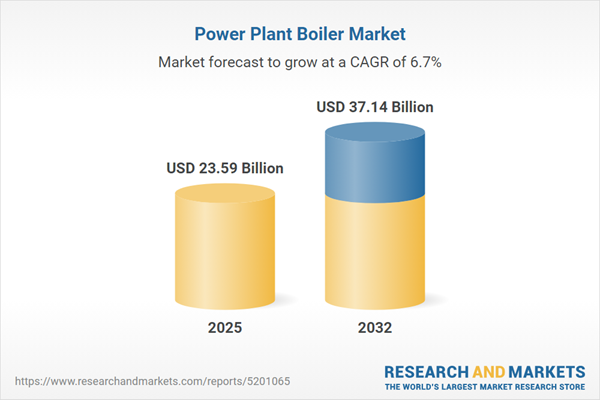Speak directly to the analyst to clarify any post sales queries you may have.
In a sector characterized by regulatory evolution and digitalization, senior leaders in the power plant boiler market must guide their organizations through a rapidly changing landscape. Success hinges on strategic agility, ongoing operational efficiency, and the ability to capitalize on emerging technologies while meeting shifting industry priorities.
Market Snapshot: Power Plant Boiler Market and Growth Trends
The global power plant boiler market is positioned for continued expansion, with a current value of USD 22.09 billion in 2024 and projections indicating growth to USD 23.59 billion by 2025, ultimately reaching USD 37.14 billion by 2032. This represents a notable CAGR of 6.70% during the forecast window.
Key drivers include increased demand for reliable electricity generation, widespread modernization efforts, and significant advancements in thermal conversion and boiler technology. Organizations with agile strategies and strong regulatory compliance are expected to achieve broader market participation across diverse global regions.Scope & Segmentation in the Power Plant Boiler Market
- Fuel Types: Biomass adoption is rising among organizations prioritizing environmental, social, and governance (ESG) objectives, aided by the regional availability of organic materials. Coal-fired boilers, though prevalent where legacy assets exist, are now modernized with energy-efficient enhancements. Natural gas boilers continue to offer operational flexibility, particularly for dual-fuel schemes and combined-cycle plants. Oil-fired and waste heat recovery solutions further contribute to operational robustness and higher asset utilization.
- Boiler Types: Fire tube boilers are implemented in settings with space or mobility constraints, while water tube boilers are emphasized for scalability and high power output at utility-scale operations. Fluidized bed and once-through models provide adaptability for varied fuels and facilitate dynamic load adjustment, supporting grid stability. Waste heat recovery boilers help organizations maximize energy efficiency by capturing and reusing residual heat.
- Pressure Classifications: Subcritical, supercritical, and ultra-supercritical boilers offer customizable solutions to address emission regulations and optimize efficiency, supporting compliance across a spectrum of policy frameworks.
- Regional Dynamics: The Americas focus on grid reliability and infrastructure modernization. EMEA demonstrates a regulatory-led approach in countries such as Germany, the UK, Saudi Arabia, and South Africa. Asia-Pacific, including China, India, Japan, and Australia, leads with large-scale industrialization and accelerated capacity growth, influenced by government policies and resource accessibility.
- Key Companies: General Electric Company, Harbin Electric Corporation, Mitsubishi Hitachi Power Systems, Doosan Heavy Industries & Construction, Babcock & Wilcox Enterprises, Bharat Heavy Electricals Limited, Thermax Limited, ABB, Kawasaki Heavy Industries, and Andritz AG are shaping the competitive landscape. These firms invest in digitalization, innovation, and cross-sector collaboration to address evolving compliance and stakeholder needs.
Key Takeaways for Senior Decision-Makers
- Integrating renewables with traditional generation is now a central strategy to enhance supply diversity and grid resilience across core markets.
- Enhanced digital controls and automation streamline compliance processes and improve overall operational flexibility, helping operators adapt more rapidly to market fluctuations.
- Applications of real-time analytics and predictive maintenance are crucial to minimize downtime, ensure timely compliance adaptation, and prolong asset performance life cycles.
- Tailoring strategies to regional conditions is recommended, with modernization leading in North America, regulatory compliance prioritized in EMEA, and accelerated capacity expansion driving Asia-Pacific plans.
- Strong ESG alignment across the sector elevates operational efficiency, emission mitigation, and water management, creating sustained organizational value.
- Resilient supply networks and strategic partnerships help reduce potential risks from changing policies and supply chain disruptions.
Tariff Impact on the Power Plant Boiler Sector
Recent US tariffs on select specialty boiler components are driving many organizations to reassess their existing supply chains. To maintain operational continuity, companies are expanding domestic sourcing, exploring regional manufacturing alternatives, and considering vertical integration, which collectively enhances resilience in the face of new trade regulations.
Methodology & Data Sources
This market analysis is grounded in executive interviews, comprehensive benchmarking against technical standards and regulations, patent landscape reviews, and review of financial disclosures. The findings are further validated through scenario modeling, independent verification, and examination of reliable industry sources to ensure the delivery of accurate, practical insights.
Why This Report Matters for Senior Leaders
- Supports informed capital planning and strategic alignment with evolving regulatory and compliance contexts.
- Provides actionable operational benchmarks and structured digital implementation frameworks that allow for market- and region-specific strategy customization.
- Highlights partnership opportunities and risk factors to guide long-term investment and adaptation to changing market dynamics.
Conclusion
Leveraging these insights enables senior leaders to better anticipate risks, implement transformative strategies, and fortify enterprise resilience during ongoing market evolution.
Additional Product Information:
- Purchase of this report includes 1 year online access with quarterly updates.
- This report can be updated on request. Please contact our Customer Experience team using the Ask a Question widget on our website.
Table of Contents
3. Executive Summary
4. Market Overview
7. Cumulative Impact of Artificial Intelligence 2025
Companies Mentioned
The companies profiled in this Power Plant Boiler market report include:- General Electric Company
- Harbin Electric Corporation
- Mitsubishi Hitachi Power Systems, Ltd.
- Doosan Heavy Industries & Construction Co., Ltd.
- Babcock & Wilcox Enterprises, Inc.
- Bharat Heavy Electricals Limited
- Thermax Limited
- ABB Ltd
- Kawasaki Heavy Industries Ltd
- Andritz AG
Table Information
| Report Attribute | Details |
|---|---|
| No. of Pages | 191 |
| Published | October 2025 |
| Forecast Period | 2025 - 2032 |
| Estimated Market Value ( USD | $ 23.59 Billion |
| Forecasted Market Value ( USD | $ 37.14 Billion |
| Compound Annual Growth Rate | 6.7% |
| Regions Covered | Global |
| No. of Companies Mentioned | 11 |









